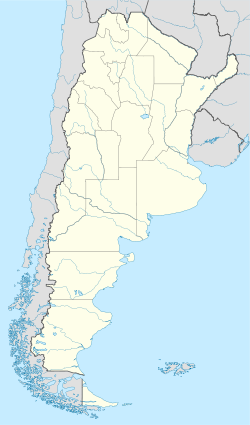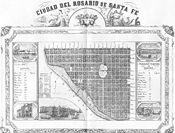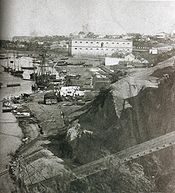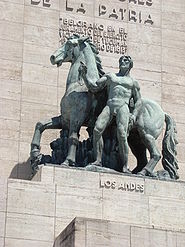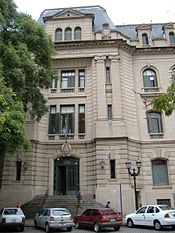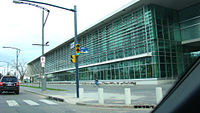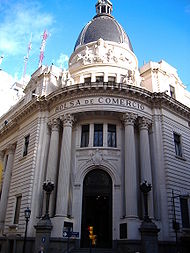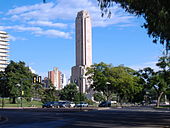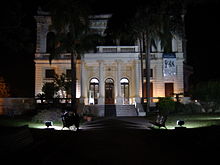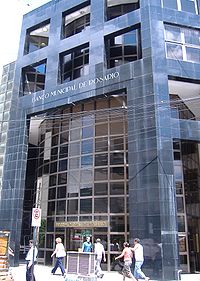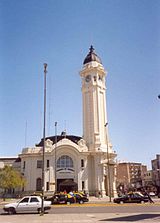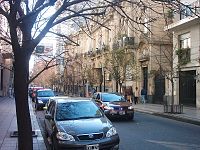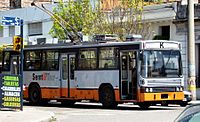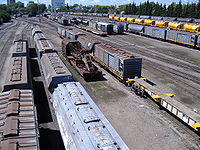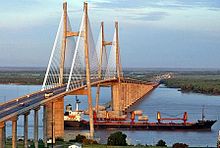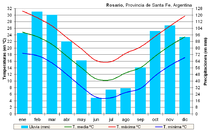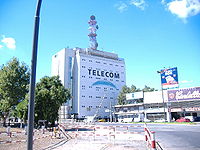- Rosario, Santa Fe
-
Rosario — City of Rosario — Clockwise from top: the National Flag Memorial's tower and propylaeum, aerial view of the city, Rosario-Victoria Bridge and the Palacio de los Leones. 
Flag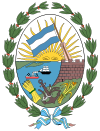
SealNickname(s): "Argentine Flag's Cradle", "The Argentine Chicago"[1][2] Location of Rosario in Argentina Coordinates: 32°57′S 60°40′W / 32.95°S 60.667°WCoordinates: 32°57′S 60°40′W / 32.95°S 60.667°W Country  Argentina
ArgentinaProvince  Santa Fe
Santa FeFounded October 7, 1793 Government – Type 6 municipal areas – Intendant Miguel Lifschitz[3] (SPA) Area – City 178.69 km2 (69 sq mi) Elevation 31 m (102 ft) Population (as of March 2001)[4] – Total 1,159,004 – Density 5,112/km2 (13,240/sq mi) Demonym Rosarian Time zone ART (UTC−3) Post code S2000 Area code 0341 Website rosario.gob.ar Rosario is the largest city in the province of Santa Fe, Argentina. It is located 300 km (190 mi) northwest of Buenos Aires, on the western shore of the Paraná River and has 1,159,004 residents as of the 2001 census [INDEC]. It is the third largest city in Argentina by its population with a growing and important metropolitan area. One of its main attractions includes the neoclassical architecture that has been retained over the centuries in hundreds of residences, houses and public buildings.
Rosario is the head city of the Rosario Department and is located at the heart of the most important industrial corridor in Argentina. The city is a major railroad terminal and the shipping center for northeastern Argentina. Ships reach the city via the Paraná River, which allows the existence of a 34 feet (10 m) deep port. The Port of Rosario is subject to silting and must be dredged periodically.[5] Exports include wheat, flour, hay, linseed and other vegetable oils, corn, sugar, lumber, meats, hides, and wool. Manufactures include flour, sugar, meat products, and other foodstuffs. The Rosario-Victoria Bridge, opened in 2004, spans the Paraná River, connecting Rosario with the city of Victoria across the Paraná Delta. Because it plays a critical role in agricultural commerce, the city finds itself at the center of a continuing debate over taxes levied on big-ticket agricultural goods such as soy.
Along with Paraná, Rosario is one of the few Argentine cities that cannot point to a particular individual as its founder. The city's patron is the Virgin of the Rosary whose feast day is on October 7. The asteroid 14812 Rosario was named in its honour.†
Contents
History
Early Settlement
Even though the city did not have a clear foundation date or any official acknowledgement thereof, most commentators state that Rosario was founded in 7 October 1793 with a local population of 457 inhabitants[6] Nonetheless the town was officially declared as city on 3 August 1852, at the time it was known as Pago de los Arroyos, that is, "land of the streams", a reference to the several small rivers that traverse the southern region of Santa Fe, like the Ludueña Stream, the Saladillo Stream and others, emptying into the Paraná River. In 1689, captain Luis Romero de Pineda received part of the lands of the Pago de los Arroyos by royal decree, as payment for services to the Spanish Crown. Before that, the area was originally inhabited by Calchaquí tribes in reducciones, a kind of missions founded by Franciscans. These missions were ultimately attacked and destroyed by hostile tribes of the Chaco.
Romero de Pineda established the first permanent settlement, an estancia — intended as farmland, not as a town. In 1719 the Jesuits bought another part and established Estancia San Miguel. The area was still so scarcely populated that it had no central authority; it was ruled from the provincial capital (Santa Fe), and in turn from Buenos Aires. In 1724 another colonial settlement was initiated by Santiago de Montenegro, who set up a mill, drew plans for the future town, built a chapel, and was appointed Mayor in 1751. The area of control of this local government extended northward from today's Rosario; only in 1784 was it divided into two smaller jurisdictions. On February 27, 1812, General Manuel Belgrano raised the newly created Argentine flag on the shores of the Paraná, for the first time. Because of this, Rosario is known as the "Cradle of the Argentine Flag". The National Flag Memorial marks the occasion.
19th Century
The province of Santa Fe greatly suffered the civil war that afflicted Argentina after 1820. Demographic growth was relatively slow. During this period, Rosario was a small settlement and a stop in the way from Santa Fe City to Buenos Aires. In 1823 it was elevated to the category of "village" (Ilustre y Fiel Villa del Rosario). Charles Darwin travelled through the area in 1832 and described Rosario as "a large town" with about 2,000 residents. In 1841 its port was shut off to foreign trade by a decree of the caudillo and Governor of Buenos Aires, Juan Manuel de Rosas which banned navigation of the Paraná and the Paraguay rivers to non-Argentine vessels.
On 25 December 1851, a small group of locals and the military guard of the city declared their support for the rival caudillo Justo José de Urquiza. As a reward for their participation in the Battle of Caseros, triumphant Urquiza wrote to the governor of Santa Fe on 9 June 1852 asking for Rosario to be granted city status. Governor Domingo Crespo justified the request at the provincial legislative body, marking the geographically strategic position of the town for national and international trade, and on 5 August Rosario was formally declared a city.
Urquiza opened up the river for free international trade. The city's economy and population expanded at an accelerated rate. By 1880, Rosario had become the first export outlet of Argentina. By 1887 it had about 50,000 inhabitants, of which 40% were immigrants, who brought new ideas from Europe and started turning Rosario into a politically progressive city (contrasting with the more conservative, aristocratic Santa Fe).
During part of the second half of the 19th century there was a movement promoting that the city of Rosario become the capital of the republic. Ovidio Lagos, founder of the oldest Argentine newspaper, La Capital, was one of the strongest defenders of this idea (one of the main avenues in Rosario now carries his name). Rosario was indeed declared the federal capital in three occasions, but each time the law received a veto of the Executive Branch (once by Bartolomé Mitre and twice by Domingo Faustino Sarmiento). In the last 15 years of the 19th century, the city more than doubled its population, in part due to immigration. In 1911 the French-owned railway company Ferrocarril Rosario y Puerto Belgrano opened a line between Rosario and Argentina's main naval base in Puerto Belgrano. By 1926, Rosario had 407,000 inhabitants, 47% of them foreign, many coming from Europe in the wake of World War I.
Contemporary History
In 1946 Rosario massively supported Juan Perón's rise to power. The city received the benefits of the nationalization and subsidizing of many industries. Perón was deposed in 1955. In 1969 workers and students took the streets to protest against the dictatorship (Rosariazo). During the dictatorship started in 1976, hundreds of citizens were "disappeared" by the government.
In 1983 Argentina returned to democratic rule but hyperinflation caused the economic collapse of the country in 1989. In Rosario there were riots with episodes of looting. Under the Menem administration the situation became worse as the industrial sector of the city was dismantled by foreign competition and agricultural exports stagnated. In 1995 unemployment in the area reached 21.1%, and a large part of Rosario's population fell below the poverty line.
Since the recovery of the national economy that followed the 2001 collapse, Rosario's economic situation has improved. The boom in agricultural exports has caused a large increase in consumer spending and investment. Mayor Miguel Lifschitz's administration is taking advantage of the economic boom to invest heavily in public works, as well as in public health (which takes up about a quarter of the whole budget).
Government
Rosario is ruled by an Executive Branch represented by a Mayor (seat: Palacio de los Leones), and a Legislative Branch, consisting of a Deliberative Council (seat: Palacio Vassallo). The Mayor is elected for a four-year term and the Council renews half of its 21 members every two years.
Municipal Centre District (CMD)
Since 1997, a municipal program of descentralization of legislative activities was carried out, materialized in 6 Municipal Centres of District (Centre, North, South, West, Northwest and Southwest). The city is divided into six large administrative districts (Center, North, Northwest, West, Southwest, and South), with Municipal District Centers that provide services to the population.
Local people and institutions have been pushing the provincial government to grant Rosario the status of Autonomous City. Some, with the sponsorship of the governors of Santa Fe, Entre Ríos and Córdoba as well as other important politicians, have put forward a legislative project to move the National Congress to Rosario, to decentralise the national government.
Since the return to democracy in 1983, the Mayors of Rosario were Horacio Usandizaga, Héctor Cavallero, Hermes Binner, and the current one, Miguel Lifschitz (of the Socialist Party, elected in 2003 and re-elected in 2007). The city does not have a police force of its own (it is served by the provincial police), but in 2004 it led to the creation of a special patrol force of unarmed officers called Guardia Urbana Municipal ("Municipal Urban Guard") which was imitated later by Buenos Aires in 2005.
. In July of 2011, Mónica Fein was elected to become the Mayor in December of 2011.
Municipal statistics
The municipality of Rosario comprises 178.69 km2, of which 117 km2 are urbanized, in 6,306 housing blocks. Of this area, 9.37 km2 (5.3%) is devoted to green spaces (parks, boulevards, plazas), which gives over 10 m2 of green space per inhabitant.
Electric power is supplied to the whole urban area and running water reaches 97% of the population (about 350,000 homes). Natural gas is provided to 227,152 homes.[7]
Since the beginning of the recovery of the national economy, the city is experiencing a real estate boom (as of 2007). In the period 2003–2006, the construction sector has added 2 million m2, investing about $900 million. Despite this increased supply, prices have increased by 10% compared to the values during the 1990s, and rents have soared by 165%.
Experts believe that this growth is propelled by the increased purchasing power of farmers around Rosario, helped by competitive exports, and the overall preference for safer investment options.[8]
Health
Rosario has a number of public health centers: 5 municipal hospitals (including a children's hospital and an emergency hospital/trauma center) and a municipal outpatient-only center, plus 2 large provincial hospitals (Hospital Provincial and Hospital Centenario), and their associated primary care centers in the city proper and its metropolitan area.
Economy
Rosario is the main epicentre of a metropolitan region whose economy is based on the services and the industry, generating the second urban gross regional product of Argentina, after the Greater Buenos Aires [9] The principal manufacturing sector is the agroindustry, whose industries are placed in the northern and southern areas of the Greater Rosario; the investments over the last decade have transformed Rosario in a major pole of processing of oil of the world [10] Many other sectors contribute to the diversified industrial offering of the city. Rosario and its metropolitan area produce 20% of the cars, 4 % of the domestic refrigerators, 80% of the machinery for the food industry and 100% of the auto bodies for long distance buses made in Argentina.
Other important sectors include the petrochemical sector, with three plants located in the suburbs of San Lorenzo and Port San Martin; the chemistry sector, with plants for sulphuric acid, fertilizers, resins and other inputs; the cellulose industry; the meat industry; ironworks; auto parts; the plants and equipment for bottled oil; agricultural machinery; and the materials and equipments for the construction industry. Worldwide international companies settled in Rosario include, among others, General Motors, Cargill, Unilever, John Deere, Petrobrás, ICI, Dow, Tenneco and Mahle.
The main financial bank at the city of Rosario is the Municipal Bank of Rosario. Its central offices are located in the financial district, on San Martín St., and there are several additional offices throughout the city. It is focused on small and medium enterprises and other organizations, especially through microcredits, and may be considered an "ethical bank". [2]
The Municipal Bank was founded in 1896 to support the financial needs of the citizens and small businesses in the highly productive region of southern Santa Fe Province, centered in Rosario. At the time, the city had around 92,000 inhabitants and was already the most important port on the Paraná River. The idea of creating a municipal financial institution was expressed in 1893 by mayor Floduardo Grandoli, citing the proliferation of "centers of usury" that exploited those in need of credit, especially the poor (something not addressed by the profile of the Provincial Bank of Santa Fe, which granted loans only to demonstrably solvent persons). Acting on this, the municipal Counseling Commission passed a bill (on 1 February 1895) dictating an "Organic Charter of the Municipal Bank of Loans and Savings Accounts". The bank opened exactly one year later.
The seat of the bank was moved in 1905. Its name was changed to its present form on 14 May 1940 by a municipal bill. Its location was moved again, and for the last time so far, in 1986. In 2006, after some political controversy, the bank was capitalized by the municipality in order to comply with new regulations dictated by the Central Bank, and transformed into a joint stock company, with only 1% of the stock belonging to the municipal state. A special clause was added, dictating that this minimum share is unchangeable, so as to prevent hypothetical attempts at privatization. [3]
The Rosario Board of Trade hosts the country's largest commodity market, dealing in cereals and oilseeds, and also the largest futures exchange (ROFEX). The banking sector includes the state-owned Municipal Bank of Rosario, with branches and offices throughout the city, and the central branch of the New Bank of Santa Fe.
The largest technological center in Argentina – Polo Tecnológico Rosario (PTR) – is located in Rosario within La Siberia site. The center focus mainly on research and development of the three following areas: biotechnology, software development and telecommunications. It currently employs 3,500 people and it is expected to grow 100% by 2015 to become one of the largest in Latin America.
Culture
Rosario has many cultural activities in many artistic disciplines with national and international reach. The city has produced important personalities in the fields of music, painting, philosophy, politics, poetry, literature, medicine, and law. Important theaters are El Círculo, Sala Lavardén, Broadway, Astengo Auditorium, La Comedia, etc. The cultural complex known as "Puerto de la Musica" -designed by the modernist architect Oscar Niemeyer- is to be built along the banks of the Paraná River. It will be one of the biggest centers for musical performance in Latin America and is scheduled to be completed by the year 2012.
The city has several museums including: Juan B. Castagnino Fine Arts Museum, Firma y Odilo Estévez Municipal Decorative Art Museum, Dr. Julio Marc Provincial Historical Museum, City Museum, and Museum of Contemporary Art of Rosario (MACRo). The Dr. Ángel Gallardo Provincial Natural Sciences Museum was rebuilt after a fire in 2003 and re-opened at a new location in 2006. There are plans to move the National Oriental Art Museum, which currently shares a building with the National Decorative Art Museum in Buenos Aires, to Rosario. Rosario has a public astronomy complex, located in Urquiza Park, which consists of an observatory (inaugurated in 1970) and a planetarium (1984).
The Fundación Italia is a cultural institution whose importance has been growing since its creation in 1985. Created by people who boast a "cultural bond with Italy" it has organized a Neapolitan music concert, a performance of Madame Butterfly and numerous talks about the present and future of Argentina. Among the people invited to give these talks were economists Domingo Cavallo and Alfonso Prat Gay, renowned scholars Beatriz Sarlo and Silvia Bleichmar, journalists Alejandro Rozitchner and Jorge Asís, filmmaker Fernando Solanas and the former presidents of Chile -Ricardo Lagos-, Argentina -Eduardo Duhalde-, and Uruguay -Luis Alberto Lacalle Herrera. As this list of invited politicians and thinkers suggests, this organization promotes cultural activities aligned with the right-wing political parties and the interests of national corporations that fiercely oppose the governments of Nestor and Cristina Kirchner. Domingo Cavallo, for instance, was the minister of Finance in Argentina during the presidency of Carlos Menem and the intellectual author of the infamous "convertibilidad", an economic policy that arguably led Argentina to the political and financial collapse of 2001.
Cultural centers
- Centro Cultural Bernardino Rivadavia
- Centro Popular de la Memoria
- Centro Cultural Islas Malvinas
- Centro Cultural Estación Provincial
- Grupo Pasajes
- Centro de Cultura & Comunicación
- Centro Cultural El Núcleo
- Centro Cultural Los Hornos
Theaters
- Teatro El Círculo
- Teatro La Comedia
- Teatro Auditorio Fundación
- Teatro Sala Lavardén
- Teatro Puerto de la Música
- Teatro Municipal Coliseo Podestá
- Anfiteatro Martín Fierro
- Teatro La Nonna
- Teatro La Hermandad del Princesa
- Sala 420
- Taller de Teatro de la UNLP
- Complejo "El Teatro"
- Teatro "La Lechuza"
Museums
- Dr. Julio Marc Provincial Historical Museum
- Dr. Ángel Gallardo Provincial Natural Sciences Museum
- Firma y Odilo Estévez Municipal Decorative Art Museum
- Juan B. Castagnino Fine Arts Museum
- Museo de Arte "Fra. Angélico"
- Municipal Museum of the City
- Museo Provincial de Bellas Artes
- Museo Municipal de Bellas Artes
- Museo de Arte "Fra. Angélico"
- Colección Dr. Emilio Azzarini
- Museo Histórico del Fuerte de la Ensenada de Barragán
- Museo y Archivo Dardo Rocha
- Museo Almafuerte
- Museo del Teatro Argentino
- Museo "José Juan Podestá"
- Museo de la Catedral
- Museo Internacional de Muñecos
- Museo del Automóvil – Colección Rau
- Museo del Tango Platense
- Museo Policial "Inspector Mayor Vesiroglos"
- Museo Histórico "Contralmirante Chalier" – Escuela Naval de Río Santiago
- Museo Histórico Militar "Tte. Julio A. Roca"
Cinemas
- Cinema San Martín
- Cinema 8
- Cinema City
- Cinema Paradiso
- Cinema Rocha
- Cine Select
- Espacio INCAA km. 60
Racecourse
Independence Hippodrome opened on December 8 of 1901, when the first ride meeting was held. The Hippodrome was located in the heart of the Parque de la Independencia and occupied a prominent place in the city's social scene. In 1919 construction began of the Popular Opinion. La Tribuna rises Partners in 1928. Moreover, it had begun the construction of a new box office. In 1941, he demolished the Tribune Paddock (formerly Partners Tribune). The final podium of Professional construidaes, begun in 1972. Independence Hippodrome was the initiator in Argentina night time racing, with lighting facilities for this purpose.
The Tracks
The racecourse features three tracks that are used for entertainment, vacation and skills.
- The Main Track: has 1794 meters of sand. This track is enabled on Monday, Wednesday and Friday for tests, and where the events Sunday competitions.
- Assistant Track 1: 1650 meters with sand. Sehabilita on Tuesdays, Thursdays, Saturdays and Sundays inclusive for the tournaments and some special courses such as race trot.
- Assistant Track 2: counts on 1450 meters of land. It is used to jog and tame.
The Tribunes
- Ex-Tribune Partners: with a privileged view of the oval track and focused, this building, equity has a covered area of 1300 m2 and three levels, the second is a restaurant with a capacity for 150 people.
- Professional-Tribune, has a covered area of 300 m2. On the ground floor is the technical area and the Commissariat sector. Currently serving food.
- Paddock-Tribune, has covered area of 900 m2. Has a gambling parlor and a VIP room with buffet area for the fans. You can find the office of the Administration and the boxes for journalists.
Libraries
- Biblioteca Central General José de San Martín
- Biblioteca Municipal Francisco López Merino
- Biblioteca de la Legislatura de la Provincia
Landmarks
National Flag Memorial
The National Flag Memorial in Rosario, Argentina, is a monumental complex built near the banks of the Paraná River. It was inaugurated on June 20, 1957, the anniversary of the death of Manuel Belgrano, creator of the Argentine flag, who raised it for the first time in an island on the opposite shore of the river on February 27, 1812.
The complex has a total area of about 10,000 square metres, and was constructed using stone primarily sourced in the Andes, under the direction of architects Ángel Guido and Alejandro Bustillo, and the sculptors José Fioravanti, Alfredo Bigatti and Eduardo Barnes.
[11] [12] The Memorial (Monumento) has three parts: the Tower (Torre) or mast, with 70 metres high, which commemorates the Revolution of May 1810 and houses Manuel Belgrano's crypt in its base; the Civic Courtyard (Patio Cívico), which symbolizes the effort of the organization of the state (the Courtyard is used for massive open-air shows), and the Triumphal Propylaeum (Propileo Triunfal), representing the Nation as organized after the 1853 Constitution. Under the Propylaeum there is the Honour Room for the Flags of America (where the flags of all American nations are displayed).
The complex faces Belgrano Avenue, and is delimited by Córdoba St. and Santa Fe St., which slopes down towards the river at this point. The Propylaeum can be accessed from the pedestrian passage called Pasaje Juramento ("Oath Passage"), which starts at Buenos Aires St. between the municipal building (Palacio de los Leones) and the Cathedral, in front of Plaza 25 de Mayo (May 25 Square). The passage is flanked by statues by famous sculptor Lola Mora.
The Memorial and the National Flag Park located in front of it are the seat of the main celebrations of Flag Day on June 20. The 50th anniversary of the inauguration of the complex, in 2007, was marked by a special celebration and by the unveiling of a new lighting system. [13]
El Puerto de la Música will be a theater with a total capacity of 30,000 people located by the Paraná River. Architect Oscar Niemeyer thought the concept by expanding the show from inside the theater to a much larger outside audience. The concrete curvilinear shape building with an area of 215,278 sq ft (20,000.0 m2) is the first design of Oscar Niemeyer in Argentina.[14] The project will be a distinctive part of Rosario's skyline. Construction will begin at the end of 2010 and is expected to be completed by 2014.
Planetarium
Loacated in park Urquiza, Rosario's Astronomic municipal Complex is one of the principal astronomic centers of the region.
The planetarium has a core team, together with its secondary elements, provide an artificial image of the sky, through projections made on a fixed hemispherical dome that functions as a display. The assembly is installed in the Room "Oscar Claudio Caprile", located in the heart of the magnificent building that is shaped like a comet. For its technical characteristics in terms of size, quality of sound and image and interior comfort, this room is considered among the best in the world. The building in the shape of comet forms a part of the complex that includes the "Prof. Victor Capolongo" observatory and the experimental science museum.
The observatory
Municipal Astronomical Observatory "Prof. Victor Capolongo" was inaugurated on June 18, 1970 and named its first director. The Observatory meets outreach, teaching and research in the field of astronomy and related sciences and informs the public of phenomena that occur in the sky, as eclipses, planetary configurations, passages of comets, etc.
To that end, the Observatory has installed two telescopes. One refractor Coudé of 150 mm. Of opening and 2250 mm of focal distance provided with Lyot's monochromatic filter for the solar observation and another reflector type Cassegrain of 300 mm. Of opening, constructed by the house Carl Zeiss. There are realized observations and astronomic photography of all the celestial visible objects in Rosario's sky, according to the epoch of the year and very specially the Sun, the Moon and the planets like Jupiter, Saturn, Mars and Venus.
Experimental science museum
It was inaugurated on September 24, 1987. It is the first that works in Argentina and differs from traditional museums iy has equipment and instruments that demonstrate the Laws of Nature, which can be used by the general public in an interactive way. Thus, visitors of all ages can be seen with telescopes and microscopes, experimenting with lasers, sound mixers, radios of various types, computers, solar cells, etc. To complement this, exhibit panels with photographs and explanatory texts of the Basic Science and Technology: Mathematics and Computer Science, Engineering, Physics, Astronomy, Astronautics, Geology, Chemistry and Biology. In addition, an important area is intended for periodic samples, such as "Space Age", Energy: renewable and rational use "", From Sand to Glass, "among others. The museum staff was achieved through contributions from the Ministry of Science and Technology Office, the Municipality of Rosario and the contribution made by institutions and individuals. The Museum audiovisual projections made in the Video Sector Science and has an area called "CIENCIANIÑO" for children 4 to 10 years. The Museum works in the evening similar to the Planetarium. Educational institutions at all levels are treated in previous days shift assignment.
Demographics
Demographic distribution
Historical populations Year Pop. ±% 1858 9,785 — 1869 23,169 +136.8% 1887 50,914 +119.8% 1900 112,462 +120.9% 1910 192,278 +71.0% 1926 407,354 +111.9% 1947 584,587 +43.5% 1960 669,173 +14.5% 1970 806,942 +20.6% 1980 956,761 +18.6% 1991 1,118,905 +16.9% 2001 1,161,188 +3.8% 2009 (est. 1,235,558 +6.4%  Diagram of the Municipal Districts of Rosario, Centre District, North District, Northwest District, West District, Southwest District and South District
Diagram of the Municipal Districts of Rosario, Centre District, North District, Northwest District, West District, Southwest District and South District
Rosario is located in the Province of Santa Fe, Argentina. This metropolis has a population of about 1.2 million (1,159,004 est.), thus being Argentina's third most populated urban settlement, after Córdoba.[15] The Greater Rosario comprises Rosario itself (population about 910,000) and a large area around it, spreading in all directions except eastward (because of the Paraná River). Directly to the south it includes the city of Villa Gobernador Gálvez, with a population of about 75,000, at about 10 km from Rosario city centre.
To the west and south-west there are several smaller towns and cities (Funes, Roldán, Pérez, Soldini); Roldán is 23 km from Rosario city centre. These settlements were incorporated into the metropolis due to their vicinity to major roads leading into Rosario, and many people living there habitually commute to Rosario.
The farthest end is to the north, following the coast of the river; from Rosario one finds, in succession and usually merging into each other, the towns of Granadero Baigorria, Capitán Bermúdez, Fray Luis Beltrán, San Lorenzo (already in a different departamento, with a population of over 40,000), and Puerto General San Martín, the last being at a distance of 35 km from Rosario.
The north of the Greater Rosario is one end of an area traditionally called Cordón Industrial ("Industrial Corridor"), since it was traditionally a heavily industrialized productive region. The prelude to the economic crisis in the 1990s largely dismantled the industrial infrastructure and damaged agricultural exports. As of 2006 the recovery of national economy has revitalized them, but high levels of poverty and unemployment persist (the last official survey indicates that 23.4% of the population is under the poverty line).[15]
In 1876 the total population was 203,509 and it doubled in 1908, and yet again in less than two decades; by 1926 Rosario had 407,000 inhabitants, 47% of them foreign, many brought from Europe in the wake of World War I. Most of them were Italian, and among them, a majority from the north-western region of Liguria. As of the census of 2001, there are 1,161,188 people residing in the city and 31 surrounding districts, making metro Rosario home to one in five Argentines[16] The population density in Rosario proper was 13,680 inhabitants per square kilometer (34,800 per mi2); but, only about 2,400 per km2 (6,100 per mi2) in the suburbs.
The 2001 Census showed a relatively aged population, as well; with 17% under the age of fifteen and 22% over sixty, the people have an age structure similar to those in most European cities. They are, likewise, a good bit more elderly than Argentines as a whole (of whom, 28% were under 15 and 14%, over 60).[16]
The ethnic make-up of Rosario changed in the late 19th-century, when significant numbers of European immigrants arrived in the city. Prior to this, Rosario's population had been almost completely European-descent in ethnic origin. As Buenos Aires was the first landfall in Argentina for many migrant ships coming from Europe in the 1850s and 1890s, Rosario started to experience a diverse influx of people,.[17] The main contributors were Spain, Italy, France, Eastern European nations such as Croatia, Poland, Russia, Romania, Ukraine and the Balkans (especially Greece, Serbia and Montenegro), Switzerland, Germany, the United Kingdom and Ireland, and Scandinavia (especially Sweden). By the 1910s, 43 percent of the city population was non-native Argentine after immigration rates peaked[18][19]
Most immigrants, regardless of origin, settled in the city or around Greater Rosario. However, in the first stages of immigration, some formed colonies (especially agricultural colonies) in different parts of the city, often encouraged by the Argentine government and/or sponsored by private individuals and organizations.
Largest cities of Argentina
(2007 INDEC estimate)[20]Rank City Name Province Pop. Rank City Name Province Pop. 
Buenos Aires
1 Buenos Aires (autonomous) 3,050,728 11 Resistencia Chaco 377,000 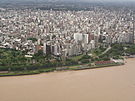
Rosario
2 Córdoba Córdoba 1,372,000 12 Corrientes Corrientes 345,000 3 Rosario Santa Fe 1,242,000 13 Bahía Blanca Buenos Aires 304,000 4 Mendoza Mendoza 885,434 14 San Salvador de Jujuy Jujuy 298,000 5 Tucumán Tucumán 789,000 15 Posadas Misiones 287,000 6 La Plata Buenos Aires 732,503 16 Paraná Entre Ríos 268,000 7 Mar del Plata Buenos Aires 604,563 17 Neuquén Neuquén 255,000 8 Salta Salta 516,000 18 Santiago del Estero Santiago del Estero 244,733 9 Santa Fe Santa Fe 493,000 19 Merlo Buenos Aires 244,168 10 San Juan San Juan 453,229 20 Quilmes Buenos Aires 230,810 Provinces of Argentina Provinces Buenos Aires · Catamarca · Chaco · Chubut · Córdoba · Corrientes · Entre Ríos · Formosa · Jujuy · La Pampa · La Rioja · Mendoza · Misiones · Neuquén · Río Negro · Salta · San Juan · San Luis · Santa Cruz · Santa Fe · Santiago del Estero · Tierra del Fuego · Tucumán

Autonomous city Districts
Rosario is divided into six districts, most named by location although the eastmost is called Centre District as it includes the oldest part of the city historicaliy called Centro (City Centre). The data given below are from the 2001 census [INDEC].
Centre District
Population: 261,047
Area: 20.37 km2 (11.45% of the Municipality)
Population density: 12,815 inhab/km2
Housing: 110,152 unitsNorth District
Population: 131,495
Area: 35.02 km2 (19.6% of the Municipality)
Population density: 3,744 inhab/km2
Housing: 40,492 unitsNorthwest District
Population: 144,461
Area: 44.14 km2 (24.7% of the Municipality)
Population density: 3,273 inhab/km2
Housing: 41,740 unitsWest District
Population: 106,356
Area: 40.21 km2 (22.5% of the Municipality)
Population density: 2,645 inhab/km2
Housing: 31,625 unitsSouthwest District
Population: 103,446
Area: 20.19 km2 (11.3% of the Municipality)
Population density: 5,123 inhab/km2
Housing: 28,284 unitsSouth District
Population: 160,771
Area: 18.76 km2 (10.5% of the Municipality)
Population density: 8,569 inhab/km2
Housing: 48,541 unitsUrban Structure
Centre District
At Rosario city centre, Córdoba Street is the main avenue, it begins at the Flag Memorial Park, climbs towards the district area, and becomes a pedestrian walk for seven blocks, between Plaza 25 de Mayo and Plaza Pringles. Along Córdoba Ave to the west Paseo del Siglo ("Walk of the Century") was settled, with former houses of wealthy families, finally there is also the San Martín Square, and elsewhere, Plaza Montenegro (on Peatonal San Martín, the pedestrian-only four blocks of San Martín Street) and Plaza Sarmiento.
Oroño Boulevard (going north–south) and Pellegrini Avenue (east–west) mark the boundaries of the town center together with the river. At their confluence starts the Parque de la Independencia, that houses the Juan B. Castagnino Fine Arts Museum, the Newell's Old Boys football club, and the sports clubs Provincial and Gimnasia y Esgrima, as well as the horse racetrack and the former Sociedad Rural (Rural Society).
Towards the south, beyond Pellegrini Avenue, there are two more boulevards, 27 de Febrero and Seguí, and avenues Uriburu, Arijón and Battle y Ordóñez. To the west, after Oroño, there are the avenues Ovidio Lagos and Francia, Avellaneda Boulevard and Provincias Unidas Avenue. The main barrios in the south are La Tablada, Parque Casado, Las Heras, Las Delicias and Las Flores. The city ends in the Saladillo Stream.
Among the districts in the west are Echesortu, Belgrano, Triángulo, Moderno, Godoy and Fisherton. To the north-east there lie Pichincha, Ludueña, Lisandro de la Torre (home of Rosario Central's stadium) and Empalme Graneros.
Next to the stadium there is the Parque Alem, and nearby the Sorrento thermal power plant. To the north lie the districts of Alberdi, La Florida (with a popular beach resort of the same name), Parque Field (built under US President John F. Kennedy's Alliance for Progress development plans) and Rucci. The main streets are Alberdi Avenue and its continuation, Rondeau Boulevard (which leads to the Rosario-Victoria Bridge and the city of Granadero Baigorria). These are crossed by the avenues Las Tres Vías, Génova, Sorrento and Puccio.
An important part of Rosario's urban character is its river bank. The city recovered the river bank of the Paraná not long ago, thanks to a reorganization of terrains formerly owned by the port and the national railroad system. Going from the center immediately north of the port, the river bank is surrounded by a large amount of parks; Argentine flag Memorial, Parque de España, Parque de las Colectividades and Parque Sunchales.
Greater Rosario
Through the years, Rosario has spread in all directions. Towards the south, beyond Pellegrini, there are two more boulevards, 27 de Febrero and Seguí, and avenues Uriburu, Arijón and Battle y Ordóñez.To the west, after Oroño, there are the avenues Ovidio Lagos and Francia, Avellaneda Boulevard and Provincias Unidas Avenue. The main neighborhoods in the south are La Tablada, Parque Casado, Las Heras, Las Delicias and Las Flores. The city ends in the Saladillo Stream (the natural border with Villa Gobernador Gálvez). This is just south of the great barrio Grandoli.
Among the neighborhoods in the west are Echesortu, Belgrano, Triángulo, Moderno, Godoy and Fisherton (near the west end of the city, formerly home of hierarchical personnel of English railroad companies established in Rosario). To the north-east there lie the neighborhoods of Pichincha (a red-light district in early 20th century, now home to an open-air antiquities fair: Mercado de antigüedades "Feria Retro La Huella"), Ludueña, Lisandro de la Torre (home of the Rosario Central football club) and Empalme Graneros; these last three are in the influence area of the Ludueña Stream, now contained by underground piping, but until the 1980s a source of floods.
Next to the Rosario Central stadium there is a large park, Parque Alem, and not far from it there stands the Sorrento thermoelectric power plant. North from the Lisandro de la Torre neighborhood there are Alberdi (formerly an independent town), La Florida (with a popular beach resort of the same name) and Rucci.
The main streets in the north are Alberdi Avenue and its continuation, Rondeau Boulevard (which leads to the north exit of the city, the access to the Rosario-Victoria Bridge and the town of Granadero Baigorria). These major arteries are crossed by several avenues: Las Tres Vías, Génova, Sorrento and Puccio.
Transportation
Rosario's strategic location is destined to become a significant transportation hub and as the bi-oceanic corridor that links the State of Rio Grande do Sul (Brazil) on the Atlantic Ocean to Valparaíso (Chile), on the Pacific, an important component in global distribution and the core center of a key corridor in the Mercosur, the Common Market for the South.[21]
Public transport
The Rosario public transport system includes buses, trolleybuses and taxicabs.
The Rosario trolleybus system consists of only one main trunk line. It is presently operated by a government-owned corporation, SEMTUR (Sociedad del Estado Municipal para el Transporte Urbano de Rosario, "Municipal State Society for Rosario Urban Transport"), as are some of Rosario's other urban bus lines.
Plaza Sarmiento is the hub of the city bus system, about 40 urban lines in the metropolitan area that provide service every 5 to 10 minutes.
Bus fares are pre-paid by means of a disposable paper card with a magnetic stripe which can be bought from post offices, automatic vending machines, and private businesses. For occasional use, a larger fare can be paid using a coin machine in the bus unit. The interurban lines have differential fares and some allow payment in cash only.
The urban bus fleet was partially renewed during the recovery of the national economy, since 2003, and consists of about 730 units. In 2005 the average age of the buses was 5 years and 11 months. Improvements in the economy have led to increased use of public transport, and comparatively less use of bicycles. According to the Rosario Transportation Office, in 2005 there were about 11 million bus journeys per month,[22] by 2007, usage has climbed to 420,000 people every day (12.6 million per month).
As a curiosity, Rosario has a large number of buses which run on natural gas, as it happens also in Argentina as a whole, and all gas stations provide it. Its price is quite low compared to the alternatives. The idea to transform all buses to this system did not prosper; most buses run on heavily subsidized diesel fuel.
Rosario has a medium-sized taxi fleet, with units painted black and outlined in yellow. Some belong to radio-taxi companies and can be reserved by telephone; others only in the streets. As the economy of Argentina recovers, the capacity of the taxi fleet has been strained by higher usage. In September 2005, the Deliberative Council approved the compulsory installation of radio-call systems in all taxi units, but this requirement has not been fulfilled.
Rosario is also a major hub for long-distance overland transportation from the Mariano Moreno Bus Terminal,[23] (Terminal de Omnibus), across from the Patio de la Madera Convention and Exposition Centre complex, about 15 blocks west of Plaza San Martin. The transportation facility serves 73 bus companies in short, medium and long-distance travel, carrying 1,100.000 passengers per month to 784 national and international destinations, which comprise most major domestic cities including Puerto Iguazú, Salta and Bariloche and international destinations such as Asunción, Paraguay, Curitiba and Rio de Janeiro, Brazil and Montevideo, Uruguay, destinations may be long but white-clad chauffeurs handle comfortable long-distance coaches with modern conveniences.
Rail
The passenger train system was severely damaged by the privatization of most railway companies in the early 1990s, but is slowly recovering. The lines of the Nuevo Central Argentino (NCA) railway company handle most of the cargo. Additionally, two private passenger railway companies provide limited services to several major cities. Trenes de Buenos Aires runs weekly trains south to Retiro Station in (Buenos Aires) and north to Santa Fe. The company Ferrocentral also operates weekly trains south to Buenos Aires and northwest to Córdoba and Tucumán.
There was a project to build a high-speed train between Buenos Aires-Rosario-Córdoba, scheduled to be started in 2008, with an inauguration in 2012, that would join Rosario and Buenos Aires in 85 minutes, and would reach Córdoba in another 90 minutes at speeds of up to 320 km/h (200 mph).[24] However it never was constructed and the project was finally suspended after the controversy it generated among the citizens and the media critics because of the high costs it implicated.[25]
Roadways
Rosario is linked to the rest of the country by a number of roads: the Aramburu Highway (southeast, to Buenos Aires), National Route 9 (from Buenos Aires to Rosario and then north and west up to Jujuy and Bolivia), the Brigadier Estanislao López Highway (north, to Santa Fe City), National Route 11 (to the north of Santa Fe, Formosa and Paraguay), National Route 33 (to the southwest of Santa Fe and the province of Buenos Aires, and then through National Route 7 to San Luis, Mendoza and Chile), National Route 34 (north to Santiago del Estero, Tucumán and Bolivia), and National Route 174 (east, to Entre Ríos, over the Rosario-Victoria Bridge).
It is surrounded with an extensive system of two belt-highways called Circunvalación Motorway and A012 which in turn set the limits of the city. The Circunvalacion beltway is 30 km (18.6 mi) and was built for traffic to avoid the congested city centre, it allows drivers to bypass the city going around it in a much shorter time.
In its 30 km (19 mi) length, it intersects with National Route 9, National Route 3, National Route 34, National Route 11 and National Route 174.
The official numbering system denotes this road as "A008" but this denomination is mostly unknown by the locals as it is still called "Avenida de Circunvalación 25 de Mayo" ("25 of May Beltway Avenue") commemorating the May Revolution of 1810. Some sections are named after different personalities by local decree. For example:
- the section from the east end on 27 Boulevard to the crossing of Ayacucho Street (old exit to the Rosario-Buenos Aires Road, now access to Provincial Route 21), is called "National Route A008 Tte. General Juan Carlos Sánchez" by decree #232 of 14 May 1981.
- the section between Eva Perón Street and the exit to Santa Fe (the state capital) on the intersection with Rondeau Boulevard is called "National Route A008 Dr. Constantino Razzetti" by law #25769 of 1 September 2003.
The A012 is a the second beltway at the southeast of the city. It has a semi-circular length centered around the city, running as a long-length beltway. From the National Route 9 junction on km marker 278, in the town of Esther, to the junction with National Route 11 on km marker 326 in the city of San Lorenzo it runs for 67 km (41.6 mi).
This road is popularly known as the Second Rosario Beltway, as it borders the metropolitan area of greater Rosario. Through National Decree 1595 of 1979[26] this road switched to federal control. Beforehand this road was called Provincial Route 16.
Airports
Main article: Rosario International AirportThe Rosario Airport is located 13 km (8.1 mi) west-northwest from the center of Rosario, a city in the Santa Fe Province of Argentina. The airport covers an area of 550 hectares (1359 acres) and is operated by the Province of Santa Fe.[27][28]
The airport serves the Greater Rosario area and is the main hub for Sol Líneas Aéreas and is also served by Aerolíneas Argentinas, Pluna and Gol Transportes Aéreos. There are domestic flights within Argentina from Rosario to Buenos Aires, Córdoba, Mar del Plata (via Buenos Aires), Mendoza (vía Córdoba), Santa Fe and Villa Gesell (via Buenos Aires) cities as well as international services to, Porto Alegre, Brazil, and Punta del Este, Uruguay (direct flight in summer and via Buenos Aires in fall, winter and spring). The airport is at an altitude of 82 feet (25 m) and its longest runway measures 9843 feet (3 kilometres).
Port
The Port of Rosario, is an inland port and a major goods-shipping centre of Argentina, located in the city of Rosario, province of Santa Fe, on the right-hand (western) shore of the Paraná River, about 550 km upstream from the Atlantic Ocean.[29] [30]
At this point of the course of the Paraná (Kilometer 420) lies the depth transition between overseas and river navigation. The main channel of the river directly in front of the port has an advantageous configuration that allows to preserve a depth of 34 feet (10 m) with minor periodic dredging. This allows for downstream navigation of vessels up to Panamax kind. The Paraná is about 600 m wide at Kilometer 418 and becomes 2,000 m wide downstream.
The port is the largest of a series located in the several cities of the Greater Rosario that lie on the Paraná; the last (northernmost) able of overseas traffic being Puerto General San Martín (23 km upstream from Rosario). It is part of the Bi-Oceanic Corridor that joins the Atlantic with the Pacific Ocean via Buenos Aires, Rosario, Córdoba, the Cuyo region and Valparaíso, Chile; going north-south it forms the axis of the Paraguay-Paraná Hydroway. It directly services the area of Santa Fe that produces a large part of Argentine exports, and indirectly the whole Mercosur trade bloc. In 2003 the traffic in the port amounted to 2.9 million tonnes.
Cargo] from other parts of Argentina is brought into the port by the railway lines of the Nuevo Central Argentino, communicating with Córdoba (west) and Zárate, Buenos Aires (south), as well as the multiple national and provincial roads and highways that converge in Rosario. Communication with the north-eastern part of the country was enhanced by the 2003 opening of the Rosario-Victoria Bridge, that joins the city with the province of Entre Ríos. The Rosario International Airport (located 15 km west) has also been refurbished to work with cargo traffic.
Education
Rosario is an important educational centre at a national and international level. It is the home of the National University of Rosario (UNR) since 1968, which includes the Law Faculty, the Medicine Faculty, the Humanities Faculty and an advanced study centre called Ciudad Universitaria de Rosario (university city) that is home to more than 10 colleges, including the Faculty of Psychology, the Faculty of Political Sciences, the Faculty of Architecture, etc. It is also home of the Rosario Regional Faculty, a branch of the National Technological University (UTN). All of these national colleges are free.
In the city there are approximately 624 establishments destined for elementary levels and secondary education, the Technical Institute, which depends directly on the UNR). With a solid tradition as for universitary education, it is head of several academic institutions, and is public, and free access.
Currently, there are some 80,000 University students at various institutions around the city, representing approximately 8.5% of the whole inhabitants. This rate is one of the highest in Argentina. In Rosario, nearly 15% of the population benefits from higher education degrees, or have undergone at least some University studies sometime.
Rosario has private colleges, as the Pontifical Catholic University of Argentina (UCA), the Austral University, the University of the Latin American Educational Center (UCEL), the Interamerican Open University (UAI), the Italian University of Rosario (IUNIR), the San Martin University and the University of Concepcion del Uruguay which are private institutions.
Language
Rosario is one of the main urban centers of the Rioplatense Spanish dialect. The intra-dialectal differences with Buenos Aires and other cities in the same area are minimal, though rosarinos aspirate and suppress their final -s more than porteños, and there are also minor lexical variants. The city has a local language game, sometimes employed as slang, called Rosarigasino (related to jeringonza).
Rioplatense Spanish, has intonation patterns that resemble those of Italian dialects, and differ markedly from the patterns of other forms of Spanish.[31] This correlates well with immigration patterns. Argentina had huge numbers of Italian settlers since the 19th century.
According to a study conducted by National Scientific and Technical Research Council of Argentina, and published in Bilingualism: Language and Cognition (ISSN 1366-7289),[32] Rioplatense speakers have an intonation most closely resembling Neapolitan. The researchers note that this is relatively recent phenomenon, starting in the beginning of the 20th century with the main wave of Southern Italian immigration.[33]
Several languages influenced the Rioplatense Spanish, because of the diversity of settlers and immigrants to Argentina:
- 1870–1890: mainly Spanish, Basque, Galician and Northern Italian speakers and some from France, Germany, and other European countries.
- 1910–1945: Again from Spain, Southern Italy and in smaller numbers from across Europe; Jewish immigration, mainly from Russia and Poland from the 1910s until after World War II was also large.
- English speakers, from Britain and Ireland, were not as great in numbers as the Italians but were influential in industry, business, education and agriculture. In the case of the English immigrants, they were certainly influential within the upper middle class.
Sports
Rosario is the home of the football clubs Rosario Central (founded 1889) and Newell's Old Boys (founded 1903). Newell's plays in the Primera División Argentina and Central descended to the First "B" in 2010 for the fourth time in history, and will play in the Primera B Nacional on the 2010/2011 season after losing the playoffs against All Boys. Central has won 4 National championships (in 1971, 1973, 1980 and in 1987) and one international title: the Conmebol Cup (currently known as Copa Sudamericana) in 1995. Newell's has 5 National championships (in 1974, 1988, 1991, 1992 and in 2004). Rosario's other football clubs are Club Atlético Central Córdoba, currently playing in Primera C Metropolitana, Club Atlético Tiro Federal Argentino in Torneo Argentino A and Argentino de Rosario in Primera D Metropolitana.
It is also the hometown of Argentine internationals Ángel Di María, Ezequiel Garay, Maxi Rodríguez, Cesar Delgado, Ezequiel Lavezzi, Éver Banega, Lionel Messi and Luciana Aymar.
Rosario is also the second choice site for Argentine rugby tests, after Buenos Aires. Famous rugby clubs from the city include Club Atlético del Rosario – one of the four UAR founding clubs – and also Jockey Club de Rosario and Duendes Rugby Club, both former winners of the Nacional de Clubes title.
Rosario has major women's hockey tournament.
Events
- Festival Latinoamericano de Video Rosario (Rosario Latin American Video Festival). Annual event (September), starting in 1994.
- Encuentro Internacional de Escultura en Madera-Piedra-Hierro de Rosario (International Meeting of Wood-Stone-Iron Sculpture in Rosario). Annual event (September/October), since 1993.
- Encuentro y Fiesta Nacional de Colectividades (Communities Meeting and National Celebration). Annual event, starting in 1985, showcasing music, song, dance, cuisine and customs of foreign communities in Argentina, in the ample room provided by the Parque Nacional a la Bandera (National Flag Park). Usually held in November; in 2004 it was postponed to the beginning of December in order to avoid overlap with the Third International Congress of the Spanish Language.
- Festival Internacional de Poesía de Rosario (International Poetry Festival). Annual event since 1993 (November).
- Festival Iberoamericano de Cine de Rosario (Ibero-American Film Festival). Annual event since 2003 (November).
- Leyendas ("Legends"). A cartoon, role-playing and science fiction convention. Annually since 1999, usually in autumn (April/May), sometimes in spring (November).
Notable people from Rosario Culture Sport Vicente de la Mata · Marcelo Bielsa · César Menotti · Ángel Di María · Éver Banega · Cesar Delgado · Kily González · Cristian Gonzales · Marcelo Delgado · Luciano Figueroa · Edgardo Bauza · Lionel Messi · Ezequiel Garay · Maxi RodríguezPolitics Entertainment Libertad Lamarque · Alberto Olmedo · Darío Grandinetti · Luis Machín · Renata Fronzi · Juan Carlos Baglietto · Fito Páez · Liliana Herrero · Litto Nebbia · José Cura · Angélica Gorodischer · Daniel RiveraGeography
The city of Rosario measures 178.69 square kilometres (not all of them are fully urbanized). Its extreme points are:
- Latitude: parallels 32º52′18″ and 33º02′22″ South.
- Longitude: meridians 60º36′44″ and 60º47′46″ West.
The geographical center is approximately at 32°57′2″S 60°42′15″W / 32.95056°S 60.70417°W (see also other cities on the same latitude).
The city is located on a smoothly undulated plain typical of the Pampas, between 22.5 and 24.6 metres above mean sea level; the original settlement rests on the ravine on the right-hand shore of the Paraná, opposite a group of islands of the Paraná Delta which are partly in the jurisdiction of the province of Entre Ríos. The nearest city across the river's flood plain (60 km) is Victoria, Entre Ríos, linked to Rosario by the Rosario-Victoria Bridge.
Rosario lies on the ravine of the right-hand shore of the Paraná, about 24 m above mean sea level, in a place with a natural slope to the low shore. The point of origin of the city is Plaza 25 de Mayo ("May 25 Square"), now surrounded by the Municipality (Palacio de los Leones), the Basilica Cathedral of Our Lady of the Rosary, the Central Post Office, the Decorative Art Museum and a building called La Bola de Nieve ("The Snowball"). Between the Cathedral and the municipal building is Pasaje Juramento ("Oath Passage"), leading to the Flag Memorial. The streets mostly follow a regular checkerboard pattern.
Climate
The Rosario area has a Pampean Humid subtropical climate (Köppen climate classification Cwa), and is well known for its changeable weather conditions. The city has average temperatures of 23.4 °C (74.12 degrees Fahrenheit) maximum and 11.6 °C (52.88 degrees Fahrenheit) minimum, and an annual rainfall of 1,038 mm (40.87 in).
Rosario is usually warmer than other mainland Argentine capital cities in the winter. The lowest average on winter is 4.4 °C (40 °F). This is due in part to the city's flat topography, its situation on the Paraná River bank, and the presence of high density of urbanization, have created a microclimate known as urban heat island that often means that the city is significantly warmer than its surrounding rural areas.
The temperature difference usually is larger at night than during the day and larger in winter than in summer, and is most apparent when winds are weak. However, snowfalls are extremely rare: the most recent occurrence of sleet in the CBD was on 9 July 2007. During the spring, Rosario commonly enjoys extended periods of mild weather and clear skies. On average, Rosario has an average between 23 °C (73 °F) and 10 °C (50 °F) but occasionally experiences hotter and drier summer days, with maximum temperatures above 35 °C (95 °F) when northerly winds blow dry air from Brazil. The record high temperature is 42.4 °C (108.3 °F) and the record low is −11.1 °C (12.0 °F)[34]
Climate data for Rosario, Argentina Month Jan Feb Mar Apr May Jun Jul Aug Sep Oct Nov Dec Year Average high °C (°F) 31
(88)29
(84)27
(81)23
(73)20
(68)16
(61)16
(61)18
(64)21
(70)23
(73)27
(81)29
(84)23 Average low °C (°F) 17
(63)17
(63)15
(59)12
(54)8
(46)5
(41)5
(41)6
(43)7
(45)11
(52)13
(55)16
(61)10 Precipitation mm (inches) 98.3
(3.87)124.1
(4.886)120.2
(4.732)88.0
(3.465)64.9
(2.555)19.5
(0.768)29.5
(1.161)31.0
(1.22)56.4
(2.22)100.6
(3.961)107.4
(4.228)93.3
(3.673)933.5
(36.752)Avg. precipitation days 9 8 9 8 6 5 4 5 5 10 9 9 86 Source: Weather Channel.[35] Broadcasting and communications
As for television, Rosario has two private local channels, Canal 3 and Canal 5 (the latter is part of the national network Telefé), and a relay station for the public national station, Canal 7 Argentina. Besides, there are three cable TV networks (the national ones Cablevisión and Multicanal, and a local net, Cablehogar), which support two local channels, Canal 4 Noticias and Canal 6.
There are four AM radio stations: three private (licensed by the state) ones, LT3 Radio 2 (LT2), and LT8, and one public, Radio Nacional Rosario, property of the national state. Among the multitude (above 200) of FM stations some notable ones are FM Vida, Estación del Siglo, FM Del Rosario, Cristal FM, Radio Hollywood, Fisherton-CNN, Continental Rosario, Radio 10 Rosario, Radiofónica, Clásica Rosario, etc.
The city has three notable newspapers: La Capital (Argentina's oldest newspaper, founded in 1867, and still published today), Rosario/12 (founded in 1991), and El Ciudadano & la Región (founded in 1999).
Rosario is located at the center of Argentina's optical fiber ring. The main data transport companies offer all their services in the city, from public phones to mobile networks and broadband Internet access through DSL, cable modem and Wi-Fi, and including public Internet navigation centers (cybercafes).
About 96% of homes have a domestic telephone line, giving a total of 472,170 lines; cell phone usage has also become pervasive, as happened in Argentina as a whole since the beginning of the 21st century, reaching over 86% of the residents (866,000 mobile lines in July 2004). This demand, boosted by low prices and sale promotions, and coupled with restrictions on the installation of antennas and alleged lack of investment by the providers, sometimes degrades the quality of the service. Most notably, the mobile network collapsed almost completely in the celebrations of Christmas, New Year's Day and Friend's Day in 2004 and 2005.
Twin cities
Rosario has a number of Twin cities around the world. Sisterhood agreements are intended to foster solidarity and collaboration between cities and regions that share historical links or common characteristics.
 Santa Cruz de la Sierra, Bolivia
Santa Cruz de la Sierra, Bolivia Alessandria, Italy
Alessandria, Italy Asunción, Paraguay
Asunción, Paraguay Bilbao, Spain
Bilbao, Spain Caracas, Venezuela
Caracas, Venezuela Dakar, Senegal
Dakar, Senegal Haifa, Israel
Haifa, Israel Imperia, Italy
Imperia, Italy Manizales, Colombia
Manizales, Colombia Montevideo, Uruguay
Montevideo, Uruguay Zahlé, Lebanon
Zahlé, Lebanon Monterrey, Mexico
Monterrey, Mexico Piraeus, Greece
Piraeus, Greece Pisco, Peru
Pisco, Peru Porto Alegre, Brazil
Porto Alegre, Brazil Shanghai, People's Republic of China
Shanghai, People's Republic of China Toulouse, France
Toulouse, France
On July 25, 2006, Rosario offered a charter of sistership to Split, Croatia.
See also
- Parana River steamers
References
- ^ Monumento Histórico Nacional a la Bandera Argentina en la página de la Municipalidad de Rosario
- ^ Página del Ministerio de Educación de la Nación sobre el Monumento Histórico Nacional a la Bandera.
- ^ Autoridades y reparticiones en la página de la Municipalidad de Rosario
- ^ INDEC: estimaciones de población
- ^ http://www.lacapital.com.ar/2006/08/30/economia/noticia_322334.shtml
- ^ History of Rosario
- ^ Municipalidad de Rosario, estadisticas Spanish
- ^ Government statistics 2 Spanish
- ^ http://www.skyscrapercity.com/showpost.php?p=16511813&postcount=277.[Skycrapercity]
- ^ http://www.clarin.com/suplementos/rural/2006/02/04/r-00601.htm[Clarin]
- ^ Monumento Histórico Nacional a la Bandera (official website, in Spanish)
- ^ ArgentinaTuristica.com (touristic guide, in Spanish)
- ^ La Capital, 20 June 2007. El Monumento se iluminó a nuevo y volvió a ser una fiesta para Rosario.
- ^ http://www.taringa.net/posts/arte/6111329/Puerto-de-la-musica-_Rosario_.html
- ^ a b INDEC, 2001 census, updated by the Permanent Home Survey (first semester 2006). Published in La Capital, 21 Sep 2006.
- ^ a b 2001 Census
- ^ Argentina
- ^ Dinámica migratoria: coyuntura y estructura en la Argentina de fines del XX
- ^ http://www.buenosaires.gov.ar/areas/hacienda/sis_estadistico/anu_estadistico/01/web01/c110.htm
- ^ "3218.0 - Instituto Nacional de Estadistica y Censos, Argentina, 2006-07". INDEC. 2008-03-31. http://www.indec.mecon.gov.ar/nuevaweb/cuadros/4/EPHcont_1trim08.pdf. Retrieved 2008-06-06.
- ^ Mercosur official website
- ^ Transporte de Rosario Spanish
- ^ Terminal de Ómnibus Mariano Moreno Spanish
- ^ TAVe, Buenos Aires – Rosario – Córdoba accessdate=2008-05-12 Spanish
- ^ http://www.andinia.com/b2evolution/index.php/noticias-viajes-turismo-entretenimiento/turismo-viajes/viajes-tren-ferrocarril/ise-le-humedecio-la-polvora-al-tren-bala
- ^ National Decree 1595/79
- ^ (Spanish) SAAR – Rosario / Islas MalvinasPDF (84.3 KB) at AIP Argentina
- ^ (Spanish) Aeropuerto Internacional Rosario "Islas Malvinas" at Organismo Regulador del Sistema Nacional de Aeropuertos (ORSNA)
- ^ Universidad Nacional de Rosario – Details about the Greater Rosario area ports.
- ^ CONICET – La ciudad y su zona de influencia tienen un polo portuario que atrae inversiones. Overview of the port economy in the Rosario area (Spanish).
- ^ http://www.unidadenladiversidad.com/actualidad/actualidad_ant/2004/mayo_2004/actualidad_050504_01.htm
- ^ http://journals.cambridge.org/action/displayAbstract?fromPage=online&aid=236145
- ^ http://www.lanacion.com.ar/762441
- ^ http://www.mherrera.org/temp.htm
- ^ [1]
External links
- Municipality of Rosario (official website)
- Rosario Cursos y Congresos Courses and Congresses in Rosario
- 360º Rosario Virtual Tour Virtual tour around Rosario with 360º panoramas
- RosarioCity (commercial website of Rosario city and its region)
- Rosariocomercio.com.ar (commercial guide of Rosario)
- (English) Ente de Turismo Rosario (tourism office)
- National University of Rosario
- Night life and entertainment
- Rosario Alternativo Short stories for the learned traveller
- (English) Administrative Entity of the Port of Rosario (ENAPRO)
- (English) Rosario Board of Trade (Bolsa de Comercio de Rosario)
- RosarioLinks (web directory)
- La Capital (online newspaper)
- El Ciudadano & la Región (online newspaper)
- Rosario.com.ar (Information to Greater Rosario)
- Rosario crece con el Puerto de la Música(online newspaper)
- RosarioMIX.com (online newspaper)
Categories:- Populated places in Santa Fe Province
- Rosario, Santa Fe
- Paraná River
- Port settlements in Argentina
- Populated places established in 1793
Wikimedia Foundation. 2010.


